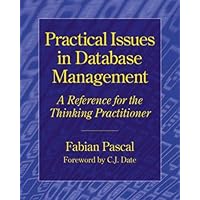
Average Reviews:

(More customer reviews)Contains discussions on widely misunderstood, but vitally important, database issues. Considers how things should be according to relational theory, what goes wrong in practice due to failing to understand these fundamental concepts, and provides practical recommendations/workarounds where possible. A bridge between theory and practice. A concise and straightforward read, although to gain maximum benefit you should already have a reasonable understanding of relational databases.
Some of the main points are as follows. Relational databases can support data types of arbitrary complexity ("objects") - but we need DBMS vendors to implement the means to provide such support. Use declarative integrity constraints when possible. Avoid tables that allow duplicate rows - ensure all tables have a primary key (may require a surrogate key). Avoid redundant data. Ensure your database is normalized - avoids numerous problems. Resist the temptation to denormalize. Recognise entity supertypes/subtypes and how to implement as tables. Minimize use of nulls whenever possible. Also discusses climbing trees and quota queries. Separate chapters discuss all these points in detail.
A constant theme throughout the book is how poorly SQL and commercial DBMSs support relational concepts, and the numerous problems this causes. Personally, I believe there is little that most application/database developers can do about this, other than suffer what gets "inflicted" upon us. Pascal urges us to pressurise DBMS vendors to provide better relational support.
This book is firmly of the view that "relational is right". If you agree, you will probably like this book. Most of the references are to C.J Date's writings. However, I suspect some people won't like this book - those who believe "relational is wrong" (e.g. some OODBMS proponents); and those who prefer a "cookbook approach" for their specific DBMS and don't really care about what the "right way" is. I suspect some people will think that Pascal should "live in the real world" rather than worrying about theory, yet this book argues that it is because of the failure to understand fundamental database concepts that leads to "real world" databases having the problems that they do.
Helps database professionals educate themselves in fundamental database concepts, and illustrates the correct way of doing things in relational databases. Well worth reading.
Click Here to see more reviews about: Practical Issues in Database Management: A Reference for the Thinking Practitioner
Databasics clearly explains the key concepts users and database professionals need to understand in order to build well-designed databases that answer business questions accurately and efficiently. Fabian Pascal, one of the industry's leading experts, identifies ten critical, recurring issues that both database users and vendors often fail to address appropriately. Pascal demonstrates why understanding these fundamentals is so important, providing detailed examples and solutions designed to help users escape the key pitfalls of database development. Among the topics covered: unstructured data and complex data types; business rules and enforcing data integrity; keys; duplicates; normalization; entity subtypes and supertypes; data hierarchies and recursive queries; redundancy; quota queries; and how to handle missing information. Along the way, Pascal offers no-holds-barred assessments of how well current SQL implementations and commercial products address each issue. Databasics, in short, is a complete guide to building databases right the first time, so they don't have to be rebuilt later.For all DBAs, developers, managers, and end-users that need to understand the best ways to design and implement database systems.

No comments:
Post a Comment